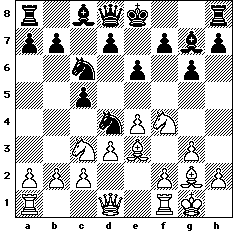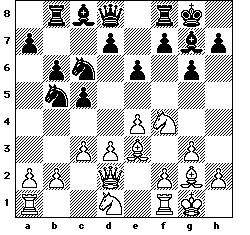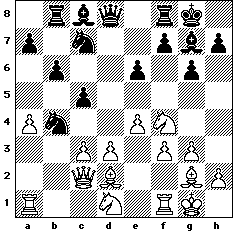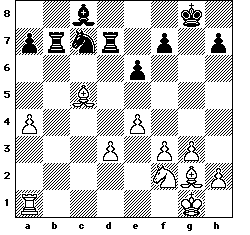
For baseball, for me at least, it's Fenway Park. The Green Monster, the nostalgia, and the fans. Every game is more an intimate night out than a sporting event.
In postal chess, for me at least, it's playing Stephan Gerzadowicz. Part of the charm, I know, is that I grew up not far from his East Templeton home. As a teenager, I attended the Fitchburg Chess Club where Stephan, George Mirijanian, Brian Warnock, and others helped me week after week to improve my play.
Stephan's postcards arrive with the same wit that we've come to expect from his columns and books. And there's his chess style, a passionate conviction in fianchettoed bishops and a slow steady buildup that lulls one opponent after another into structural suicide. It's almost as if Stephan has discovered the deep, hidden nature of the game, the precise tempo of play dictated by the obscure space-time relationships in chess. I've often thought that we have all been taught to play incorrectly, valuing too greatly the power and beauty of the mate in three while undervaluing the precise ways in which each piece affects the space around it. I know that Stephan understands all of this better than the rest of us.
When I play Stephan, I can sense the change in my own play from the first moves. A rededication to pawn structure, an extreme sensitivity to the placement of every piece, and a healthy respect for Stephan's use of the long diagonal. Thanks to Stephan, I've developed an admiration for waiting moves and, most recently, knight sorties into the corners.
I have already published two of our games. Here's our third, an important one for me in my quest for the 87 Rook championship. This game is less spectacular than our other two; in fact, there are a couple of annoying oversights here. All told, however, I think that it's a fair advertisement of how the game is most often played.
The astute reader will notice, by the by, that I have yet to get white against Stephan in a correspondence game. Then I, too, can wage slow war against 1...g6. Better yet, maybe I'll try 1.b3 or 1.h4.
SG: "I was always patient with those who thought well of me, and accepted all of their tributes with something more than resignation."
- Oliver Wendell Holmes
Though with Jon, there's that too.
1. e4 c5
2. Nc3 Nc6
3. Nge2
Andy Soltis calls this the Chameleon Sicilian because white retains the possibility of playing either open lines (with d4) or closed lines (with d3). The move order has some sting because white, not black, can determine the character of the game. Should black choose an active defense, perhaps with ...Qc7 or ...Nf6, white can enter lines of the Closed Sicilian in which those moves have less meaning. Similarly, after an early commitment by black to play in a closed formation, with ...g6 for example, white can immediately open up the position with d4.
If there's a problem with the idea, it is that the development of the Ng1 to e2 is itself inflexible in some closed lines, particularly the one into which this game develops. In the Closed Sicilian, white usually wants to place the knight behind a pawn on f4 in order to maintain a retreat for the Nc3. More on that later.
3. -- e6
This move is useful in both the closed and open lines. Often, in the Closed Sicilian, black develops with ...e6 and ...Nge7. On f6, the black knight would be subject to attack from advancing pawns and black would have a much more difficult time combating f4-f5.
4. g3 Nge7 !?
Soltis's main lines are 4...Nf6!? and 4...d5, neither of which appear to fare very well. 4...Nge7 shows up only in a sub-line. The idea is simple enough. Black wants to reinforce ...d5 and to support an eventual ...Nd4 with ...Ne7-c6. Larsen-Huebner, Mallorca 1970 continued 5.Bg2 Nd4 6.Nxd4 cxd4 7.Ne2 Nc6 8.0-0 Be7 9.d3 d6 10.c3! dxc3 11.bxc3 0-0 12.Rb1 b6 13.Be3 Bb7 14.Qd2 Qd7 15.c4 when black could have achieved at least equality with 15...Ne5!
5. Bg2 Nd4
I like this idea because it brings to the game a faster tempo that Stephan usually likes to avoid. He can open the position with Nxd4 or else permit black to defend d4 with ...Nec6. It's a bit like the Princeton-Georgetown game, with Stephan trying to slow things down and me trying the fast break at every reasonable opportunity. As I recall, Georgetown won that one, but only by a point at the buzzer.
6. 0-0 !?
With this move, we transpose into a line of the Closed Sicilian that seems fine for black. The black knights are properly deployed while the king knight ought to be on f3.
6. -- Nec6
7. d3 g6
8. Be3 Bg7
Compare this to usual positions in the Closed Sicilian. White would normally play f4 and Nf3 with the idea of Nc3-e2 and c3 (to displace the black Nd4). In this ideal set-up, white can often displace the black Nd4 without having to permit an exchange of a pair of knights which would lessen the material available for white's kingside onslaught. Leave it to Stephan to find a new solution.
9. Nf4 !?

SG: Better, doubtless, is 9.Nd1 (or 9.Rae1 first). But I wanted a board full of pieces. And more specifically, I didn't want to "allow" ...Nxe2. I wanted to punish ...Nc6-d4, ...Ne7-c6 by pushing him back with c3.
A cynic might ask if this punishment doesn't inconvenience white rather more than it does black? Am I punching him in the fist with my nose?
What I most like to do is learn. That's the big reason to avoid ...Nd4xe2+. I've seen that happen in dozens of Closed Sicilians; seeing it once more won't teach me anything. The interesting thing is to find the line between Sound and Unsound and see how far you can wobble along it. THAT's where the knowledge lies. Against some opponents, this line is as wide as Yassar's smile. Against Jon, it's pencil thin. And he keeps jiggling his end...
JRE: Ah, yes. Let there be pieces! I remain amazed by this move, which aims to drive away the Nd4 without permitting a knight exchange. But there it is, and I don't dare hit it with ...g5 or he'll kill my nice Bg7 with Nh5.
Still, I think that Nf4 is a bit too ambitious. Eventually, black will be able to gain space with ...g5 or ...e5, when the knight just might not have such a nice place to go.
9. -- 0-0
JRE: A five day think... on principle. I thought I knew what was going on. Now I'm not so sure. What exactly is that knight on f4 doing... perhaps Nh3 with the idea of f4? But then he'll have a hard time using his h-pawn in the kingside attack. But after Qd2, Nd1, c3, just where is MY nice knight going to wind up? I can't attack him with ...e5 or ...g5, but then again, the Nf4 isn't a pawn en route to f5. Perhaps I should just let it sit there while it gets in the way of his own attack.
10. Qd2 Rb8
JRE: As is the custom in the Closed Sicilian, black plays ...Rb8 to take the rook off the dangerous diagonal and to prepare queenside operations with ...b5.
11. Nd1 b6
I need to guard the c-pawn after his c3.
12. c3 Nb5 ?!
JRE: Bad moves like this seem to happen to players when they enter Stephan's universe. I was so mesmerized by the Nf4 that I failed to notice that my knight didn't need to move (cxd4 ...cxd4 traps the white Be3!). I deserve to be lambasted for not even considering 12...Ba6! which pins the d3 pawn (and stops d4).

13. a4 Nc7
14. f3 ?!
SG: I had been thinking about 14.d4, but I didn't like the look of 14...e5 in reply. Taking is shaky - 15.dxe5 Nxe5 when he's after my key Queen's Bishop with ...Nc4 or ...Ng4.
Perhaps I should have spent more time on 15.Ne2. I was worried about 15...Na5, eying b3 and c4. For example: 16.Qc2 Nc4 17.Bc1 cxd4 18.cxd4 Ba6 when b3 is out. - 19...exd4 20.bxc4 d3. Maybe white is then OK with 19.d5 but I didn't like ...Rc8, ...Nd6, ...f5. [JRE: How `bout 19.dxe5 !? and 20.f4]
A computer might play 14.Nh3 with the idea of f4 or Bh6. A foolish mortal hesitates to use a third move to land on a square that might have been reached in one.
JRE: Phew! I expected 14.d4! e5 15.Ne2! when his whole position seems to explode and my awful d-pawn and Bc8 seem real liabilities. After the knight's five-move journey in time to f4, it did indeed have a future, right back on the square from which it started. Wasn't it Einstein who first explained that?
SG: 14.f3 was played in view of the potentially embarrassing ...d5-d4 and to free the f2-square for the Nd1. I've doubled knights on f2 and f3 often; rarely on f2 and f4. All this time trying to ignore the faint nosebleed and the tremors underfoot. (It's a bad sign when its easier to find metaphors than moves).
JRE: Gees! Stephan thinks about doubling knights the way the rest of us think about doubling rooks.
14. -- d5
JRE: Come to think about it... my knights are doubled too! That's what happens when you play Stephan. You start valuing things that never before seemed important before. Now by this logic, my position must be better, because I doubled first!
Those of you who've followed my games know how I also treasure leaving my Queen's Bishop at home. From c8, it eyes, a6 and h3, leaves open the possibility of Bb7 and a later ...Be6. Life is good.
15. Qc2 d4
16. Bd2 dxc3
17. bxc3
JRE: It's the right time to attack. I like my king's bishop and I don't like his. His Nd1 will be OK in a move or two, but it isn't right now. His Ra1 is on the long diagonal, and even his bishops are blocked in. I could develop first with ...Ba6, but then he just plays Nf2. Still, I have to make sure I use the right move order. On 17...g5 18.Nh3 Nb4 19.Qb3!
17. -- Nb4!

SG: THERE'S BLOOD ON ALL THESE PAPERS! And I'm balancing by standing sideways, waving my arms in little circles, bobbing my head back and forth.
18. Qb1
JRE: There's no hope in 18.cxb4 Bxa1 or 18...Qd4+.
18. -- g5
SG: Bravo! It never seems right to me for Black to part with his Bg7 for a knight (or anything else, frankly), but he is doing fine after 19.Nh5 Nd3 (JRE: 19...Qxd3? 20.Qc1!) 20.Nxg7 Kxg7 21.Bxg5 Qxg5 (JRE: I think that 21...f6! is even better) 22.Qxd3 Rd8 and ...Rd2.
Rather than play a positionally inferior, materially equal position, I always like to take my chances with disparate pieces. Any similarity between disparate and desperate is mere coincidence.
19. cxb4 Qd4+!
JRE: White gets off the hook after 19...gxf4 20.Ra3 (over-protecting d3) 20...Qd4+ 21.Nf2 fxg3 22.hxg3 cxb4 23.Bxb4 Rd8 24.Bc3. White might also be able to get away with 19...gxf4 20.Bxf4!? with the makings of good piece play on the queenside.
20. Nf2
JRE: All of the alternatives lose quickly.
20.Ne3 gxf4 -+
20.Be3 Qxa1 21.Qxa1 Bxa1 22.Ne2 cxb4 -+
20.Kh1 Qxa1 21.Qxa1 Bxa1 22.Nh3 cxb4 23.Bxb4 Rd8 24.Nxg5
20.Rf2 Qxa1 21.Qxa1 Bxa1 22.Nh3 cxb4 23.Bxb4
20. -- Qxa1
21. Qxa1 Bxa1
22. Rxa1 gxf4
23. Bxf4 Rb7
24. bxc5 bxc5
25. Bd6 Rd8
26. Be7
SG: Because the rook would be less active on e8. I don't know that inducing 26...Rd7 really made any difference, but I couldn't resist stalemating his bishop. But Jon has the most patient Queen's Bishop in the East.
26. -- Rd7
27. Bxc5

JRE: After a long forced sequence, my first chance to breathe. So another long think. I'm up the exchange for two pawns, but that really doesn't tell the story. His Bg2 and Nf2 remain out of play... and I may be able to keep them that way with ...e5 and ...f6. My Bc8 is laughably undeveloped, but it still looks as if it'll have a promising future on b7 or a6. But it's my rooks that tell the story. He's got no way to keep them from ruling the queenside.
27. -- Na6
28. Be3
SG: 28.Ba3 didn't seem active enough. And I had decided that my best chance was to keep the two bishops. Yes?
28. -- Nb4
29. Rd1
JRE: And he really can't exchange rooks either. 29.Rc1 Rbc7 30.Rxc7 Rxc7 31.d4 Nc2 and the curtain comes down.
29. -- f6!
JRE: The idea is to fix the structure with ...e5 and to make room for the king. There's no rush in taking on d3: 29...Nxd3? 30.Rxd3 Rxd3 31.Nxd3 Rb3 32.Bxa7! The immediate 29...e5? opens up lines for white with 30.Bh3 Rdc7 31.Bxc8 Rxc8 32.Ng4. And now, my king can enter the action after 30.Bh3 Kf7.
30. e5
SG: Too concerned with him immobilizing my pawns with 30...e5 perhaps. Today I might try 30.Bf1 and seek adventures with Ng4
JRE: I hoped for 30.Ng4 Rxd3 31.Rxd3 Nxd3 32.Nxf6+ Kf7 33.Ng4 Rb1+ 34.Bf1 Nb2 -+
30. -- Nd5
JRE: Not 30...f5? 31.g4!
31. Bd4 Rb4
32. Bc5
SG: Doesn't 31.Bc5 look good?
JRE: 32.Rc1 Rc7!
32. -- Rxa4
33. f4
JRE: 33.Ne4 Rc7 34.d4 Ne3 -+
33. -- f5
34. Bxd5
SG: Hated to do it, but I feared that this Bishop would be exchanged in even less favorable circumstances after ...Bb7.
34. -- Rxd5
35. d4 Rd7
JRE: So that after 36.g4 Rg7
36. Kf1
SG: Can't be best, but Black is winning. Too many queenside pawns.
36. -- Ba6+
JRE: The sound of trumpets please. The bishop moves for the first time on move 36!
37. Kg1 Ra2
38. Rb1 Bb7
39. Kf1 Kf7
40. h3 Ba6+
41. Kg1 Rb7
42. Rxb7 Bxb7
43. g4 Kg6
JRE: The a-pawn's worth a piece.
0-1